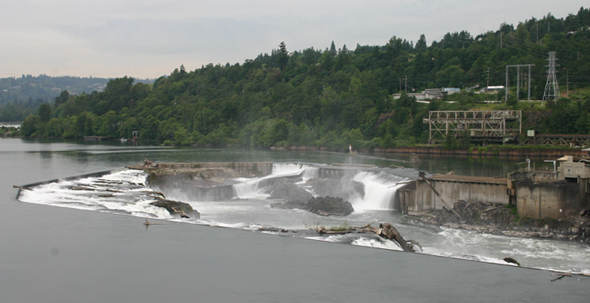
Most people don't know there is more to visiting Willamette Falls than just stopping at one of the two viewpoints alongside Interstate 205 or Highway 99E. It's a natural resource with a long history that continues today along the Willamette River.
"People stop by the viewpoints and they look at the falls for 20 minutes and leave," says Sandy Carter, director of the Willamette Falls Heritage Foundation. "They miss out on all the history and information about the falls and what it has meant to Oregon City and the state."
Carter, along with her foundation, have worked hard to not only keep a museum of the history of the falls and the locks open, but are also trying to get better signage for the viewpoints so visitors know where to look to find out more about the 42-foot-tall horseshoe-shaped basalt cascade.
The museum, located along the oldest continuously operating multi-lift lock and canal system in the United States, offers a glimpse into the history of not only the development that today surrounds the falls, but also how native Americans used the falls as fishing grounds.
"The museum is self guided and we urge people to sign in the guest book so we know how many people are visiting," Carter says as she walks up the stairs in the museum. "It has a lot of information about the how the locks were designed and the falls."
By visiting the museum, which is about a quarter-mile walk from the West Linn Police Department parking lot, you could even get the special treat of seeing boats go through the locks and watch how the locks operate. The museum is housed in the old lockmaster's office, so you have the perfect vantage point when boats come through the lock system. It's worth the wait.
The pathway down to the locks has about three staircases, and can be a little tricky to find. Ask gatehouse personnel - a paper mill straddles the falls - for directions is a good idea of you are unclear where to go. Since the museum is surrounded by a working business, make sure you watch out for forklifts and other traffic.
There is so much history about the locks themselves, that you could spend an afternoon reading and learning about how the locks were built, how they were operated in their heyday and what their fate is today.
If industry and the history of the locks around the falls aren't your cup of tea and you would rather get up close and personal with the falls, a trip on the Belle of the Falls is in order.
Available during the summer months during the weekends, the small sternwheeler will take you to the base of the falls and let you feel the spray hit your face. The one-hour tour will take you to the base of the falls. Costs vary from $38 for a family pass to $15 for adults and $7 for children between the ages of three and 12. Reservations on the 49-passanger voyages are not available except for bigger groups. For more information about trips, please email them at staff@belleofthefalls.com.
About the Willamette Falls: The Willamette Falls is a horseshoe-shaped block waterfall caused by a basalt shelf in the river bottom. The 42-foot-high and 1,500-foot-wide falls occurs 26 river miles upstream from the Willamette's confluence with the Columbia River. It's the largest waterfall by water volume in the Northwest and the 18th largest by volume. Around the falls are the locks, which are the oldest continuously operating multi-lift lock and canal system in the United States.
Tips: If you are interested in the history and importance of the falls and the locks to the local area, make sure you visit more than the two viewpoints along the highway. While the viewpoints offer stunning views, they don't give people enough information about this natural wonder. If you do decide to visit the museum along the Willamette Falls locks, don't be afraid to ask for directions.
The walk to the museum is about a quarter of a mile, so make sure you dress for the weather. If you want to make sure you can see a boat go through the locks, contact the lockmaster's office at 503-656-3381 and they can tell you when boats are scheduled to go through.
What to bring: Museum tours are free, so all you will need is your camera and your curiousity. Binoculars can also help you see some of the details of the rocks and wildlife around the falls.
Getting There: Viewpoints for the Willamette Falls are located along Highway 99E just south of downtown Oregon City and Interstate 205 (milepost 7.5), again south of the city. The 99E viewpoint offers closer looks at the falls, but the 205 viewpoint is higher up, so you can see more of the surrounding bluffs and scenery.
To board the Belle of the Falls: Take Interstate 205 to the McLoughlin Boulevard/Oregon City exit then travel north on McLoughlin Boulevard to Clackamette Drive. Turn left on Clackamette Drive to the transit dock
Getting to the locks: Take Interstate 205, exit at West Linn (exit 8), turn south onto Highway 43, and south again onto Mill Street on the west side of the Oregon City Bridge. Parking is available in the parking lot by City Hall off of Mill Street.
For more information about the history of the falls, contact them at 503-650-9570.
Patrick Johnson
For Oregon.com